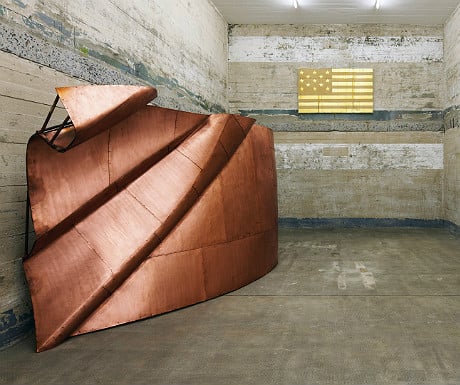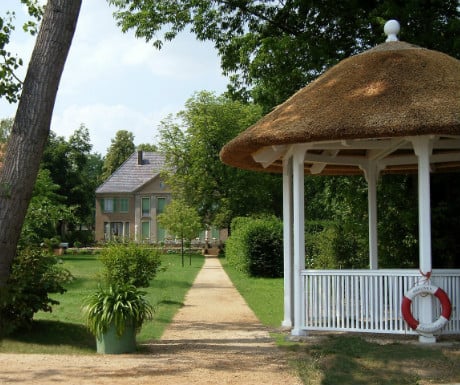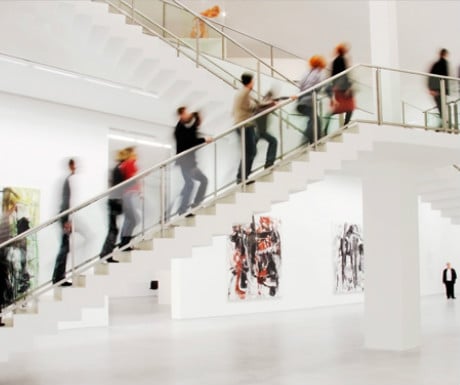Attractions · Europe · Germany · Going Out · Regions · Western Europe
Berlin’s top ‘lesser known’ art galleries
As the gorgeous European summer fades into memory and the leaves begin turning orange and gold here in the Tiergarten, it’s worth having a look at more indoor-oriented activities which are suited to a rainy day in Berlin during Autumn or Winter. In fact, much of Berlin’s cultural scene only comes to life after the Summer tourists have disappeared. With an abundance of art galleries and museums, you will not be searching for things to do during an off-season holiday in Berlin. Whether you prefer traditional (Pergamon, Old National Gallery), modern (Hamburger Bahnhof, New National Gallery) or downright quirky (Sugar Museum, Museum of Letters) Berlin has something to meet every taste. For this post I’ve chosen to focus on five of the lesser known, more out-of-the-way art galleries where you can escape the tourist throng.
Boros Collection
An old WWII bunker built to house 2000 people during the bombing raids has had a diverse history. After the war first a prison for german soldiers captured by the Russians, then a fruit warehouse in East Berlin, then a roaring techno nightclub in the 90’s it is now one of the most exciting modern art experiences Berlin has to offer. Polish collector Christian Boros now owns the bunker and has converted the top floor into a 1,000 sq meter penthouse in which he and his wife live. The other floors house their private modern art collection (post-1990) and is open to the public only by appointment (reservations via their website). Displaying works by such artists as Ai Wei Wei, Damien Hirst or Olafur Eliasson (amongst others) this gallery is an absolute must see – not just for the art alone, but also for a glance inside a magnificent architectural structure which is in itself a piece of Berlin’s history.
 Gemäldegalerie
When the Berlin Wall was constructed in 1961, Berlin’s famous ‘Museum Island’ was in the Eastern sector of the city and West Berliners no longer had access. So West Berlin built a whole new ‘Cultural Forum’ on the edge of Tiergarten which included the Gemäldegalerie, or ‘Painting Gallery’. One of the lesser known jewels of Berlin’s many art galleries it houses one of the worlds finest collection of art from the 13th-18th Century. Exihibiting works by artists including Rubens, Caravaggio, Bruegel and Vermeer (amongst others) one of the highlights would have to be the octagonal Rembrandt Room at the heart of the building. With 16 paintings it is one of the largest collections of his works. Situated right opposite the Philharmonic it makes for a wonderful late afternoon excursion before a concert.
Museum Berggruen
Heinz Berggruen was born in Berlin to Jewish parents and fled the Nazi state in 1936, emigrating to America. After the war he founded an art gallery in Paris exhibiting some of the rising artists of the day and became Pablo Picasso’s art dealer. Finally returning to Berlin in 1996 (60 years after fleeing) he opened his gallery opposite the Charlottenburg Schloss, featuring many works by Picasso and other artists such as Paul Klee, Paul Cezanne and Henri Matisse. He finally sold the collection the city of Berlin in 2000 at a quarter of it’s valued price and features some 165 works including a study by Picasso from 1897 when the artist was just 16 years old. A must see for any lover of early 20th Century art.
Villa Max Liebermann
Situated on the glorious Wannsee Lake in the south west of Berlin sits the former villa of Max Liebermann, Germany‘s most influencial impressionist painter. Born the son of a wealthy Jewish textile manufacturer in Berlin, Liebermann went on to rise to fame and become the head of the Prussian Academy of Arts – a position he resigned when the Nazis came to power and forbade the exhibition of any works by Jewish artists. His former summer villa was then appropriated by the Nazi government, and after the war was used by the surgical department of the Wannsee Hospital (Liebermann’s former atelier was an operating theatre!). It was finally sold to the city of Berlin who in turn leased it to a scuba diving club. Since 2006 it has been restored and open to the public as a museum run by the Max Liebermann Society with a permanent exhibition of the artist’s work. The beautiful garden features in many of the famous paintings and has been almost fully restored.
Gemäldegalerie
When the Berlin Wall was constructed in 1961, Berlin’s famous ‘Museum Island’ was in the Eastern sector of the city and West Berliners no longer had access. So West Berlin built a whole new ‘Cultural Forum’ on the edge of Tiergarten which included the Gemäldegalerie, or ‘Painting Gallery’. One of the lesser known jewels of Berlin’s many art galleries it houses one of the worlds finest collection of art from the 13th-18th Century. Exihibiting works by artists including Rubens, Caravaggio, Bruegel and Vermeer (amongst others) one of the highlights would have to be the octagonal Rembrandt Room at the heart of the building. With 16 paintings it is one of the largest collections of his works. Situated right opposite the Philharmonic it makes for a wonderful late afternoon excursion before a concert.
Museum Berggruen
Heinz Berggruen was born in Berlin to Jewish parents and fled the Nazi state in 1936, emigrating to America. After the war he founded an art gallery in Paris exhibiting some of the rising artists of the day and became Pablo Picasso’s art dealer. Finally returning to Berlin in 1996 (60 years after fleeing) he opened his gallery opposite the Charlottenburg Schloss, featuring many works by Picasso and other artists such as Paul Klee, Paul Cezanne and Henri Matisse. He finally sold the collection the city of Berlin in 2000 at a quarter of it’s valued price and features some 165 works including a study by Picasso from 1897 when the artist was just 16 years old. A must see for any lover of early 20th Century art.
Villa Max Liebermann
Situated on the glorious Wannsee Lake in the south west of Berlin sits the former villa of Max Liebermann, Germany‘s most influencial impressionist painter. Born the son of a wealthy Jewish textile manufacturer in Berlin, Liebermann went on to rise to fame and become the head of the Prussian Academy of Arts – a position he resigned when the Nazis came to power and forbade the exhibition of any works by Jewish artists. His former summer villa was then appropriated by the Nazi government, and after the war was used by the surgical department of the Wannsee Hospital (Liebermann’s former atelier was an operating theatre!). It was finally sold to the city of Berlin who in turn leased it to a scuba diving club. Since 2006 it has been restored and open to the public as a museum run by the Max Liebermann Society with a permanent exhibition of the artist’s work. The beautiful garden features in many of the famous paintings and has been almost fully restored.
 Berlinische Galerie
Another wonderful modern art collection, this time in a former glass storage warehouse, it is another space worth visiting not simply for the art but for the architecture of the space itself. Founded by a citizen’s association in 1975 it moved into it’s new and permanent home in 2004. The collections focus on Berlin artists since 1870 and include Dada Berlin, the Neue Sachlichkeit (New Objectivity) and the Eastern European avant-garde. The history of art in Berlin is closely tied to it’s political history and art of the divided era as well as post-reunification feature greatly in the collection with particularly some of the photographic works providing great insight into the life of Berlin as a city.
Berlinische Galerie
Another wonderful modern art collection, this time in a former glass storage warehouse, it is another space worth visiting not simply for the art but for the architecture of the space itself. Founded by a citizen’s association in 1975 it moved into it’s new and permanent home in 2004. The collections focus on Berlin artists since 1870 and include Dada Berlin, the Neue Sachlichkeit (New Objectivity) and the Eastern European avant-garde. The history of art in Berlin is closely tied to it’s political history and art of the divided era as well as post-reunification feature greatly in the collection with particularly some of the photographic works providing great insight into the life of Berlin as a city.
 Penelope Hassmann is Owner of Berlin Private Tours.
If you would like to be a guest blogger on A Luxury Travel Blog in order to raise your profile, please contact us.
Penelope Hassmann is Owner of Berlin Private Tours.
If you would like to be a guest blogger on A Luxury Travel Blog in order to raise your profile, please contact us.
 Gemäldegalerie
When the Berlin Wall was constructed in 1961, Berlin’s famous ‘Museum Island’ was in the Eastern sector of the city and West Berliners no longer had access. So West Berlin built a whole new ‘Cultural Forum’ on the edge of Tiergarten which included the Gemäldegalerie, or ‘Painting Gallery’. One of the lesser known jewels of Berlin’s many art galleries it houses one of the worlds finest collection of art from the 13th-18th Century. Exihibiting works by artists including Rubens, Caravaggio, Bruegel and Vermeer (amongst others) one of the highlights would have to be the octagonal Rembrandt Room at the heart of the building. With 16 paintings it is one of the largest collections of his works. Situated right opposite the Philharmonic it makes for a wonderful late afternoon excursion before a concert.
Museum Berggruen
Heinz Berggruen was born in Berlin to Jewish parents and fled the Nazi state in 1936, emigrating to America. After the war he founded an art gallery in Paris exhibiting some of the rising artists of the day and became Pablo Picasso’s art dealer. Finally returning to Berlin in 1996 (60 years after fleeing) he opened his gallery opposite the Charlottenburg Schloss, featuring many works by Picasso and other artists such as Paul Klee, Paul Cezanne and Henri Matisse. He finally sold the collection the city of Berlin in 2000 at a quarter of it’s valued price and features some 165 works including a study by Picasso from 1897 when the artist was just 16 years old. A must see for any lover of early 20th Century art.
Villa Max Liebermann
Situated on the glorious Wannsee Lake in the south west of Berlin sits the former villa of Max Liebermann, Germany‘s most influencial impressionist painter. Born the son of a wealthy Jewish textile manufacturer in Berlin, Liebermann went on to rise to fame and become the head of the Prussian Academy of Arts – a position he resigned when the Nazis came to power and forbade the exhibition of any works by Jewish artists. His former summer villa was then appropriated by the Nazi government, and after the war was used by the surgical department of the Wannsee Hospital (Liebermann’s former atelier was an operating theatre!). It was finally sold to the city of Berlin who in turn leased it to a scuba diving club. Since 2006 it has been restored and open to the public as a museum run by the Max Liebermann Society with a permanent exhibition of the artist’s work. The beautiful garden features in many of the famous paintings and has been almost fully restored.
Gemäldegalerie
When the Berlin Wall was constructed in 1961, Berlin’s famous ‘Museum Island’ was in the Eastern sector of the city and West Berliners no longer had access. So West Berlin built a whole new ‘Cultural Forum’ on the edge of Tiergarten which included the Gemäldegalerie, or ‘Painting Gallery’. One of the lesser known jewels of Berlin’s many art galleries it houses one of the worlds finest collection of art from the 13th-18th Century. Exihibiting works by artists including Rubens, Caravaggio, Bruegel and Vermeer (amongst others) one of the highlights would have to be the octagonal Rembrandt Room at the heart of the building. With 16 paintings it is one of the largest collections of his works. Situated right opposite the Philharmonic it makes for a wonderful late afternoon excursion before a concert.
Museum Berggruen
Heinz Berggruen was born in Berlin to Jewish parents and fled the Nazi state in 1936, emigrating to America. After the war he founded an art gallery in Paris exhibiting some of the rising artists of the day and became Pablo Picasso’s art dealer. Finally returning to Berlin in 1996 (60 years after fleeing) he opened his gallery opposite the Charlottenburg Schloss, featuring many works by Picasso and other artists such as Paul Klee, Paul Cezanne and Henri Matisse. He finally sold the collection the city of Berlin in 2000 at a quarter of it’s valued price and features some 165 works including a study by Picasso from 1897 when the artist was just 16 years old. A must see for any lover of early 20th Century art.
Villa Max Liebermann
Situated on the glorious Wannsee Lake in the south west of Berlin sits the former villa of Max Liebermann, Germany‘s most influencial impressionist painter. Born the son of a wealthy Jewish textile manufacturer in Berlin, Liebermann went on to rise to fame and become the head of the Prussian Academy of Arts – a position he resigned when the Nazis came to power and forbade the exhibition of any works by Jewish artists. His former summer villa was then appropriated by the Nazi government, and after the war was used by the surgical department of the Wannsee Hospital (Liebermann’s former atelier was an operating theatre!). It was finally sold to the city of Berlin who in turn leased it to a scuba diving club. Since 2006 it has been restored and open to the public as a museum run by the Max Liebermann Society with a permanent exhibition of the artist’s work. The beautiful garden features in many of the famous paintings and has been almost fully restored.
 Berlinische Galerie
Another wonderful modern art collection, this time in a former glass storage warehouse, it is another space worth visiting not simply for the art but for the architecture of the space itself. Founded by a citizen’s association in 1975 it moved into it’s new and permanent home in 2004. The collections focus on Berlin artists since 1870 and include Dada Berlin, the Neue Sachlichkeit (New Objectivity) and the Eastern European avant-garde. The history of art in Berlin is closely tied to it’s political history and art of the divided era as well as post-reunification feature greatly in the collection with particularly some of the photographic works providing great insight into the life of Berlin as a city.
Berlinische Galerie
Another wonderful modern art collection, this time in a former glass storage warehouse, it is another space worth visiting not simply for the art but for the architecture of the space itself. Founded by a citizen’s association in 1975 it moved into it’s new and permanent home in 2004. The collections focus on Berlin artists since 1870 and include Dada Berlin, the Neue Sachlichkeit (New Objectivity) and the Eastern European avant-garde. The history of art in Berlin is closely tied to it’s political history and art of the divided era as well as post-reunification feature greatly in the collection with particularly some of the photographic works providing great insight into the life of Berlin as a city.
 Penelope Hassmann is Owner of Berlin Private Tours.
If you would like to be a guest blogger on A Luxury Travel Blog in order to raise your profile, please contact us.
Penelope Hassmann is Owner of Berlin Private Tours.
If you would like to be a guest blogger on A Luxury Travel Blog in order to raise your profile, please contact us.Did you enjoy this article?
Receive similar content direct to your inbox.

